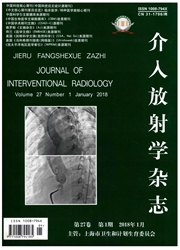

 中文摘要:
中文摘要:
目的探讨经足背-足底(TDP)或足底-足背(TPD)动脉环逆行腔内血管成形术与常规顺行血管成形术治疗膝下动脉闭塞性病变的临床疗效。方法回顾性分析2009年10月至2011年7月接受常规顺行血管成形术的96例膝下动脉闭塞性病变患者112条患肢,其中27条顺行手术失败患肢接受经TDP或TPD动脉环逆行腔内血管成形术。根据手术前踝-臂指数(ABI)、基于冠状动脉造影的心肌梗死溶栓(TIMI)后血流评分(TIMI评分)及足背或足底动脉搏动评分,评价比较顺行血管成形术治疗成功组(常规组,71例患者85条患肢)和经TDP或TPD动脉环逆行腔内血管成形术治疗成功组(逆行组,20例患者22条患肢)术后肢体挽救率及靶血管通畅率。结果逆行组和常规组手术成功率分别为75.9%和74%(P〉0.05),ABI分别由术前0.55±0.21和0.56±0.14改善为术后0.93±0.19和0.89±0.18(P〉0.05);逆行组和常规组TIMI评分分别由术前0.1±0.5和0.8±0.8改善为术后2.5±0.6和1.8±0.8(P〈0.000 1),逆行组患者远侧足部组织获得更好血流灌注。逆行组和常规组术后12、24个月靶血管一期通畅率分别为63.6%(14/22)、45.5%(10/22)和52.9%(45/85)、37.6%(32/85)(P〉0.05)。术后24个月Kaplan-Meier生存分析曲线评价显示逆行组和常规组肢体挽救率分别为95.5%和96.5%(P〉0.05)。结论与常规顺行血管成形术相比,经TDP或TPD动脉环逆行腔内血管成形术治疗膝下动脉闭塞性病变可获得更好的即刻血流改善情况以及相似的ABI改善情况、一期通畅率及肢体挽救率,可作为顺行血管成形术失败后的有效替补治疗方法。
 英文摘要:
英文摘要:
Objective To compare the clinical efficacy of transdorsal- to- plantar(TDP) or transplantarto- dorsal(TPD) retrograde endovascular angioplasty in treating below- the- knee arterial occlusion diseases,and to compare it with conventional anterograde endovascular angioplasty. Methods A total of 96 patients with below- the- knee arterial occlusion diseases(112 diseased lower extremities in total), who were admitted to authors' hospital during the period from Oct. 2009 to July 2011 to receive conventional anterograde endovascular angioplasty, were enrolled in this study. The clinical data were retrospectively analyzed. Among the 112 diseased lower extremities, conventional anterograde endovascular angioplasty failed in 27, and TDP or TPD retrograde endovascular angioplasty had to be carried out. A total of 71 patients(85 diseased lower limbs) were successfully treated with conventional anterograde endovascular angioplasty(routine group),while 20 patients(22 diseased lower limbs) were successfully treated with retrograde endovascular angioplasty(retrograde group). The preoperative ankle- brachial index(ABI), the coronary angiography- based thrombolysis in myocardial infarction(TIMI) flow score, the dorsal or plantar arterial pulse score, the postoperative limb salvage rate and target vessel patency rate were calculated, and the results were compared between the two groups. Results The technical success rate in the retrograde group and the routine group was 75.9% and74.0% respectively(P0.05). Preoperative ABI value of the retrograde group and the routine group was 0.55±0.21 and 0.56±0.14 respectively, after the treatment which increased to 0.93±0.19 and 0.89±0.18 respectively(P 0.05). Preoperative TIMI score of the retrograde group and the routine group was 0.1 ±0.5 and 0.8 ±0.8respectively, which significantly increased to 2.5±0.6 and 1.8±0.8 respectively(P0.000 1). In the retrograde group, the blood flow perfusion of the distal foot tissue was improved. The pri
 同期刊论文项目
同期刊论文项目
 同项目期刊论文
同项目期刊论文
 期刊信息
期刊信息
